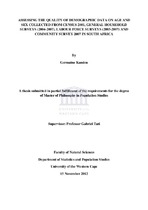| dc.description.abstract | In many countries, an enumeration of all household members remains the most important source of population statistics. According to Statistics South Africa, two population censuses and quite a few household surveys have taken place across the country. The quality of data recorded varies according to the operation. Despite great improvement in data collection and analysis capacities,some of the demographic data provided have not been assessed in terms of quality. The aim of this study was to ascertain the accuracy of demographic data on age and sex collected and the coverage during the population census 2001, General Household Surveys (2004 and 2007), Labour Force Surveys (2005 and 2007) and Community survey 2007 in South Africa. Two methods were applied to assess the quality of data. First, the direct method consists of checking the content and coverage (errors during enumeration, errors of exploitation, concordance in questionnaire). Second, the indirect method lies in the calculation of some indexes, age ratios,sex ratios, graphing of population pyramids and sex ratios curves. The indexes are Whipple’s index, Myer’s index and the Combined index of United Nations. Therefore, the main variables of interest are age, sex, place of residence and ethnic groups. Differentials in the quality according to declaration on age by gender, by ethnic group, by place of residence have been explored. This study has identified some variations in different indexes between 2001 and 2007 and has also evaluated the ethnic, gender and regional differentials. Comparison between indexes of each instrument has been done to measure some variations over years. Also, time-space comparisons were conducted across indexes of different instruments. The quality of data on age was better at national level compared to provincial level. Therefore, based on the measurements and patterns observed in the census and surveys data, the study has made some recommendations on the need for an integrated approach to reduce the gap and improve the quality of declarations on age and sex. | en_US |

